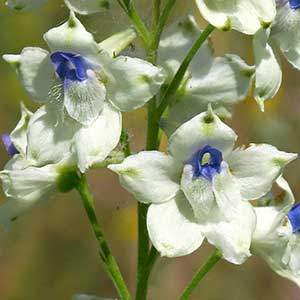Delphinium nuttallii subsp. ochroleucum
(synonym of Delphinium leucophaeum)
Delphinium elatum
pale larkspur, white rock larkspur
candle larkspur, candle larkspur (vascan: harms 2006), larkspur
30-60 cm.
40-200 cm;
base green, pubescent or glabrous.
blade round to pentagonal, 3-15 × 6-22 cm, ± puberulent; ultimate lobes 3-9, width 8-30 mm.
25-100(-more)-flowered;
pedicel 1-3(-5) cm, glabrous to pubescent;
bracteoles 2-5(-9) mm from flowers, green, linear, 5-9 mm, ± puberulent.
sepals white or light yellow, spurs 9-11 mm;
lower petal blades 4-6 mm.
sepals blue, white, or purple, ± puberulent, lateral sepals spreading, 12-23 × 4-12 mm, spurs straight, ascending ca. 45° above horizontal, 15-22 mm;
lower petal blades elevated, exposing stamens, 3-5 mm, clefts 0.2-1 mm;
hairs sparse or dense, mostly near center of blade, yellow or white.
13-20 mm, 3.5-4.5 times longer than wide, ± puberulent.
winged;
seed coats ± with small wavy ridges, cells elongate, surface roughened.
= 16.
Delphinium nuttallii subsp. ochroleucum
Delphinium elatum
Of conservation concern.
The range of morphologic features of Delphinium nuttallii subsp. ochroleucum (D. leucophaeum) is almost completely encompassed within that of D. nuttallii subsp. nuttallii. Sepal color is the only feature consistently separating the two subspecies. Were it not for the fact that any given population typically has plants of only one flower color, a rank of forma would be more appropriate.
(Discussion copyrighted by Flora of North America; reprinted with permission.)
Delphinium elatum is cultivated as a garden plant or for cut flowers. It is not known to be naturalized extensively in North America; it may persist long after cultivation in cooler parts of the region.
(Discussion copyrighted by Flora of North America; reprinted with permission.)


